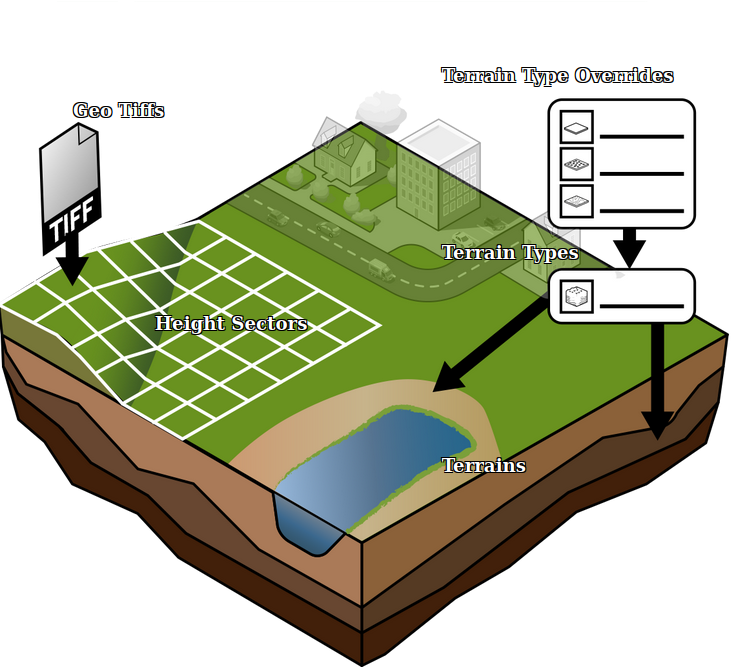|
|
| (26 intermediate revisions by 3 users not shown) |
| Line 1: |
Line 1: |
| {{being_updated}}
| | [[File:Api_current_situation_geography.png|thumb|right|400px|[[Terrain]]s in relation to [[Terrain Type]]s and [[Height sector]]s.]] |
| | The composition of the surface (above-ground) and sub-surface (underground) in the [[Project]] is defined using Terrains. A Terrain has a polygons indicating its boundaries and a [[Terrain Type]] indicating its type. For every location in the project, two terrains will be present: one [[layer|surface layer]] Terrain and one [[layer|underground]] Terrain. |
|
| |
|
| {{learned|how the {{software}} treats terrain|which terrain types are present in the {{software}}|about the meaning of the different terrain attributes|where to find and how edit terrains in a project}} | | ===Terrain Type=== |
| | {{main|Terrain Type}} |
| | The Terrain polygons each have an associated [[Terrain Type]], which holds the actual data of what the Terrain polygon represents. Only the [[Terrain Type]] holds any [[Attribute]]s to define the Terrain's behavior. |
|
| |
|
| [[File:QA wanner terrain building wiki3.jpg| link=https://www.tygron.com/nl/2020/04/17/wanneer-is-iets-een-terrain-in-tygron-en-wanneer-juist-een-building-en-waarom/]] | | ===Terrain elevation=== |
| | {{main|Elevation model}} |
| | Although conceptually related, the [[elevation model|height of the Terrain]] is explicitly not part of the Terrain itself or of the [[Terrain Type]]s. Instead, based on the presence or selection of specific [[Terrain Type]]s, modifications to the [[elevation model]] are made. For example, replacing a terrain with a type of [[water (Terrain Attribute)|water]] will cause a change for the [[elevation model]], but that change can be suppressed. |
|
| |
|
| (In Dutch)
| | Terrains define what [[Terrain Type]] is present for any given location, and thus how the ground behaves. The [[elevation model]] defines the height of the ground for any given location. |
|
| |
|
| ==What is meant by Terrain?==
| | {{article end |
| The {{software}} uses the term ''terrain'' to describe the composition of the surface, subsurface and their elevation in a project. This does not include any features built upon it, which are known as [[construction]]s.
| | |notes=* When creating a new project in the Netherlands, the default Terrains and their [[Terrain Type]]s are based on data from the [[Project_Sources#BRO|BRO]]. |
| {{editor location|terrains}}
| | * Terrains are never edited directly. Instead, users draw or import geometries for alternative Terrain Types. |
| | |howtos=* [[How to manually change the Terrain]] |
| | |seealso=* [[Terrain Type]] |
| | * [[Elevation model]] |
| | * [[Height map]] |
| | * [[Underground Overlay]] |
| | }} |
|
| |
|
| ==Surface== | | [[File:QA wanner terrain building wiki3.jpg| link=https://www.tygron.com/nl/2020/04/17/wanneer-is-iets-een-terrain-in-tygron-en-wanneer-juist-een-building-en-waarom/]]<br>(In Dutch) |
| The {{software}} differentiates between various types of terrain. Each terrain type has its own predefined attributes that may have an effect on various [[indicators]] and [[Overlay|overlays]], such as [[Green (Indicator)|green]], [[Livability (Indicator)|livability]] and [[Rainfall_(Overlay)|rainfall flooding]]. A description of all available terrain types is listed in the table below.
| |
|
| |
|
| {| class="wikitable"
| | {{Template:Editor current situation nav}} |
| ! EN
| |
| ! NL
| |
| ! Description
| |
| |-
| |
| |Breakwater
| |
| |Golfbreker
| |
| |A construction designed to protect the coastline from wave action.
| |
| |-
| |
| |Concrete
| |
| |Beton
| |
| |Commonly found in urban and industrial areas.
| |
| |-
| |
| |Dunes
| |
| |Duinen
| |
| |A naturally occurring landscape feature forming the division between the beach and the hinterland.
| |
| |-
| |
| |Grassland
| |
| |Grasland
| |
| |Area dominated by grass vegetation.
| |
| |-
| |
| |Open land
| |
| |Open land
| |
| |The default terrain type for land surface. If an empty world is generated, this type will cover the entire map.
| |
| |-
| |
| |Levee
| |
| |Dijk
| |
| |A construction usually built between a water body and low-lying land (polder) offering protection from flooding.
| |
| |-
| |
| |Sand
| |
| |Zand
| |
| |Area largely consisting of sandy sediment.
| |
| |-
| |
| |Sea
| |
| |Zee
| |
| |Water that is part of a sea or ocean.
| |
| |-
| |
| |Waterbody
| |
| |Watervlakte
| |
| |A water body which is often not part of a 'managed' water system.
| |
| |-
| |
| |Waterway
| |
| |Waterloop
| |
| |A waterway which is often part of a 'managed' water system
| |
| |}
| |
| | |
| Each surface terrain type contains the following attributes:
| |
| {{terrain attributes table start}}
| |
| {{:buildable (Terrain Attribute)}}
| |
| {{:ground infiltration md (Terrain Attribute)}}
| |
| {{:heat effect (Terrain Attribute)}}
| |
| {{:livability effect (Terrain Attribute)}}
| |
| {{:polder water (Terrain Attribute)}}
| |
| {{:safety (Terrain Attribute)}}
| |
| {{:terrain mix (Terrain Attribute)}}
| |
| {{:texture type (Terrain Attribute)}}
| |
| {{:water (Terrain Attribute)}}
| |
| {{:water depth m (Terrain Attribute)}}
| |
| {{:water evaporation factor (Terrain Attribute)}}
| |
| {{:water manning (Terrain Attribute)}}
| |
| {{table end}}
| |
| | |
| ==Subsurface==
| |
| The {{Software}} differentiates between various types of subsurface terrain types. Subsurface terrain data was originally acquired from [[GEO_Data|FGR]], however, as of version 2019.0.0 this has become [[GEO_Data|BRO]]. The [[Underground_(Overlay)|Subsurface Overlay]] shows the different soil types composing the subsurface, each having distinctive predefined attributes.<!-- that affect the [[Water_Overlays|Water Overlays]].--> The table below shows a division into the different terrain categories, which, in turn, have their own subdivisions into multiple subsurface soil types.
| |
| | |
| {| class="wikitable"
| |
| ! EN
| |
| ! NL
| |
| ! Description
| |
| |-
| |
| |Gravel
| |
| |Grind
| |
| |
| |
| |-
| |
| |Clay
| |
| |Klei
| |
| |
| |
| |-
| |
| |Chalk <!--Suggestion: Lime or calcareous soil-->
| |
| |Krijt <!--Suggestie: Kalk-->
| |
| |
| |
| |-
| |
| |Loam
| |
| |Leem
| |
| |
| |
| |-
| |
| |Loess
| |
| |Löss
| |
| |
| |
| |-
| |
| |Unknown
| |
| |Onbekend
| |
| |Default, if no subsurface data is available.
| |
| |-
| |
| |Silt
| |
| |Silt
| |
| |
| |
| |-
| |
| |Peat
| |
| |Veen
| |
| |
| |
| |-
| |
| |Sand
| |
| |Zand
| |
| |
| |
| |-
| |
| |Marine clay
| |
| |Zeeklei
| |
| |
| |
| |}
| |
| | |
| | |
| Each subsurface terrain type contains the following attributes:
| |
| Each surface terrain type contains the following attributes:
| |
| {{terrain attributes table start}}
| |
| {{:angle of repose (Terrain Attribute)}} | |
| {{:buildable (Terrain Attribute)}}
| |
| {{:ground infiltration md (Terrain Attribute)}}
| |
| {{:peat fraction (Terrain Attribute)}}
| |
| {{:toplayer thickness (Terrain Attribute)}}
| |
| {{:water storage percentage (Terrain Attribute)}}
| |
| {{table end}}
| |
|
| |
|
| | | [[Category:Items]][[Category:Terrain]] |
| {| class="wikitable"
| |
| ! Attribute
| |
| ! Unit
| |
| ! Description
| |
| |-
| |
| |ANGLE_OF_REPOSE
| |
| |{{angle}}
| |
| |The different subsurface types each attain a value for the maximum slope (Dutch: talud). This value is used for creating the water edge steepness and indirect for the water depth.
| |
| |-
| |
| |BUILDABLE
| |
| |{{boolean}}
| |
| |Attribute determining whether or not the subsurface tolerates the construction of new buildings.
| |
| |-
| |
| |GROUND_INFILTRATION_MD
| |
| |m/d
| |
| |Infiltration capacity of the surface soil into the subsoil. This attribute is used in calculations of the [[Water Overlay]].
| |
| |-
| |
| |PEAT_FRACTION
| |
| |fraction
| |
| |The fraction of the subsurface which will be considered to be peat by the [[Subsidence Overlay]].
| |
| |-
| |
| |TOPLAYER_THICKNESS
| |
| |m
| |
| |The depth of the clay soil layer, as considered by the [[Subsidence Overlay]]
| |
| |-
| |
| |WATER_STORAGE_PERCENTAGE <!--It is actually a fraction, not a percentage-->
| |
| |fraction
| |
| |Fraction of the volume of water that can be stored per volume of soil, usually expressed as the saturated minus residual water-content properties of the soil.
| |
| |}
| |
| | |
| ==Elevation==
| |
| From the Terrain tab, the user can choose to manually change the current surface elevation model in the project, or to import one in the form of a GeoTIFF file. More information regarding the elevation model can be found on the [[Terrain_height|terrain height]] page.
| |
| | |
| {{Template:Editor current situation nav}}
| |

